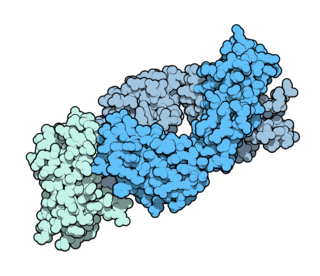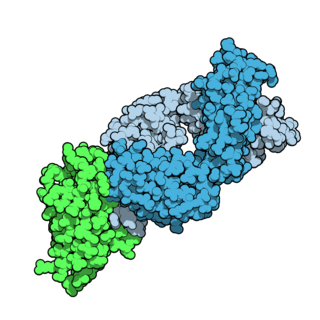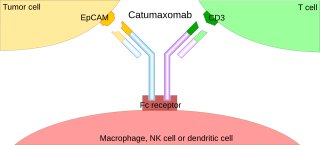Related Research Articles

Skin cancers are cancers that arise from the skin. They are due to the development of abnormal cells that have the ability to invade or spread to other parts of the body. There are three main types of skin cancers: basal-cell skin cancer (BCC), squamous-cell skin cancer (SCC) and melanoma. The first two, along with a number of less common skin cancers, are known as nonmelanoma skin cancer (NMSC). Basal-cell cancer grows slowly and can damage the tissue around it but is unlikely to spread to distant areas or result in death. It often appears as a painless raised area of skin that may be shiny with small blood vessels running over it or may present as a raised area with an ulcer. Squamous-cell skin cancer is more likely to spread. It usually presents as a hard lump with a scaly top but may also form an ulcer. Melanomas are the most aggressive. Signs include a mole that has changed in size, shape, color, has irregular edges, has more than one color, is itchy or bleeds.
Immunotherapy or biological therapy is the treatment of disease by activating or suppressing the immune system. Immunotherapies designed to elicit or amplify an immune response are classified as activation immunotherapies, while immunotherapies that reduce or suppress are classified as suppression immunotherapies.

Malignancy is the tendency of a medical condition to become progressively worse.

Melanoma, also redundantly known as malignant melanoma, is a type of skin cancer that develops from the pigment-producing cells known as melanocytes. Melanomas typically occur in the skin, but may rarely occur in the mouth, intestines, or eye. In women, they most commonly occur on the legs, while in men, they most commonly occur on the back. About 25% of melanomas develop from moles. Changes in a mole that can indicate melanoma include an increase in size, irregular edges, change in color, itchiness, or skin breakdown.

Cancer immunotherapy is the stimulation of the immune system to treat cancer, improving on the immune system's natural ability to fight the disease. It is an application of the fundamental research of cancer immunology and a growing subspeciality of oncology.

Solanum nigrum, the European black nightshade or simply black nightshade or blackberry nightshade, is a species of flowering plant in the genus Solanum, native to Eurasia and introduced in the Americas, Australasia, and South Africa. Ripe berries and cooked leaves of edible strains are used as food in some locales, and plant parts are used as a traditional medicine. In South Africa made into a jam called "Nastergal Konfyt". A tendency exists in literature to incorrectly refer to many of the other "black nightshade" species as "Solanum nigrum".

Targeted therapy or molecularly targeted therapy is one of the major modalities of medical treatment (pharmacotherapy) for cancer, others being hormonal therapy and cytotoxic chemotherapy. As a form of molecular medicine, targeted therapy blocks the growth of cancer cells by interfering with specific targeted molecules needed for carcinogenesis and tumor growth, rather than by simply interfering with all rapidly dividing cells. Because most agents for targeted therapy are biopharmaceuticals, the term biologic therapy is sometimes synonymous with targeted therapy when used in the context of cancer therapy. However, the modalities can be combined; antibody-drug conjugates combine biologic and cytotoxic mechanisms into one targeted therapy.

Sorafenib, is a kinase inhibitor drug approved for the treatment of primary kidney cancer, advanced primary liver cancer, FLT3-ITD positive AML and radioactive iodine resistant advanced thyroid carcinoma.

Solanum linnaeanum is a nightshade species known as devil's apple and, in some places where it is introduced, apple of Sodom. The latter name is also used for other nightshades and entirely different plants elsewhere, in particular the poisonous milkweed Calotropis procera.

Betulinic acid is a naturally occurring pentacyclic triterpenoid which has antiretroviral, antimalarial, and anti-inflammatory properties, as well as a more recently discovered potential as an anticancer agent, by inhibition of topoisomerase. It is found in the bark of several species of plants, principally the white birch from which it gets its name, but also the ber tree, selfheal, the tropical carnivorous plants Triphyophyllum peltatum and Ancistrocladus heyneanus, Diospyros leucomelas, a member of the persimmon family, Tetracera boiviniana, the jambul, flowering quince, rosemary, and Pulsatilla chinensis.
Bavituximab (PGN401) is a human-mouse chimeric monoclonal antibody against phosphatidylserine, which is a component of cell membranes that is exposed when a cell is transformed into solid tumor cancer cell or dies, and when cells are infected with hepatitis C. The process of cell death is highly controlled and so there usually no immune response to phosphatidylserine but when bavituximab binds to it, the conjugate appears to stimulate an immune response in humans.

Ipilimumab, sold under the brand name Yervoy, is a monoclonal antibody medication that works to activate the immune system by targeting CTLA-4, a protein receptor that downregulates the immune system.

Tremelimumab is a fully human monoclonal antibody against CTLA-4. It is an immune checkpoint blocker. Previously in development by Pfizer, it is now in investigation by MedImmune, a wholly owned subsidiary of AstraZeneca. It has been undergoing human trials for the treatment of various cancers but has not attained approval for any.

Solasonine is a glycoalkaloid that is found in Solanum plants of the family Solanaceae. Solasonine is a poisonous chemical compound when used at high levels. It is a glycoside of solasodine. Glycoalkaloids such as Solasonine have various applications including pharmacology, cancer treatments and even a role as a pesticide.

Solamargine is a cytotoxic chemical compound that occurs in plants of the family Solanaceae, such as potatoes, tomatoes, and eggplants. It has been also isolated from Solanum nigrum fungal endophyte Aspergillus flavus. It is a glycoalkaloid derived from the steroidal alkaloid solasodine.

A trifunctional antibody is a monoclonal antibody with binding sites for two different antigens, typically CD3 and a tumor antigen, making it a type of bispecific monoclonal antibody. In addition, its intact Fc-part can bind to an Fc receptor on accessory cells like conventional monospecific antibodies. The net effect is that this type of drug links T cells and monocytes/macrophages, natural killer cells, dendritic cells or other Fc receptor expressing cells to the tumor cells, leading to their destruction.

Zoptarelin doxorubicin consists of doxorubicin linked to a small peptide agonist to the luteinizing hormone-releasing hormone (LHRH) receptor. It has been developed as a potential treatment for a number of human cancers. The LHRH receptor is aberrantly present on the cell surface of approximately 80% of endometrial and ovarian cancers, 86% of prostate cancers and about 50% of breast cancers. Whereas in normal tissues, expression of this receptor is mainly confined to the pituitary gland, reproductive organs and hematopoietic stem cells. To a lesser extent the LHRH receptor is also found on the surface of bladder, colorectal, and pancreatic cancers, sarcomas, lymphomas, melanomas, and renal cell carcinomas.

Nivolumab, sold under the brand name Opdivo, is a medication used to treat a number of types of cancer. This includes melanoma, lung cancer, malignant pleural mesothelioma, renal cell carcinoma, Hodgkin lymphoma, head and neck cancer, urothelial carcinoma, colon cancer, esophageal squamous cell carcinoma, liver cancer, gastric cancer, and esophageal or gastroesophageal junction (GEJ) cancer. It is used by slow injection into a vein.

Pembrolizumab, sold under the brand name Keytruda, is a humanized antibody used in cancer immunotherapy that treats melanoma, lung cancer, head and neck cancer, Hodgkin lymphoma, stomach cancer, cervical cancer, and certain types of breast cancer. It is given by slow injection into a vein.

PD-1 inhibitors and PD-L1 inhibitors are a group of checkpoint inhibitor anticancer drugs that block the activity of PD-1 and PDL1 immune checkpoint proteins present on the surface of cells. Immune checkpoint inhibitors are emerging as a front-line treatment for several types of cancer.
References
- ↑ Cham BE, Gilliver M, Wilson L (1987). "Antitumour effects of glycoalkaloids isolated from Solanum sodomaeum". Planta Med. 53 (1): 34–6. doi:10.1055/s-2006-962612. PMID 3575510.
- ↑ Cham BE, Daunter B (1990). "Solasodine glycosides. Selective cytotoxicity for cancer cells and inhibition of cytotoxicity by rhamnose in mice with sarcoma 180". Cancer Lett. 55 (3): 221–5. doi:10.1016/0304-3835(90)90122-E. PMID 2257540.
- ↑ Cham BE, Daunter B (1990). "Solasodine glycosides. In vitro preferential cytotoxicity for human cancer cells". Cancer Letters. 55 (3): 209–20. doi:10.1016/0304-3835(90)90121-D. PMID 2257539.
- ↑ Cham BE, Daunter B, Evans RA (1991). "Topical treatment of malignant and premalignant skin lesions by very low concentrations of a standard mixture (BEC) of solasodine glycosides". Cancer Lett. 59 (3): 183–92. doi:10.1016/0304-3835(91)90140-D. PMID 1913614.
- ↑ Punjabi S, Cook LJ, Kersey P, Marks R, Cerio R (2008). "Solasodine glycoalkaloids: a novel topical therapy for basal cell carcinoma. A double-blind, randomized, placebo-controlled, parallel group, multicenter study". Int J Dermatol. 47 (1): 78–82. doi:10.1111/j.1365-4632.2007.03363.x. PMID 18173610.[ dead link ]
- ↑ Solbec Pharmaceuticals. Retrieved on 15 October 2008. Archived June 24, 2008, at the Wayback Machine
- ↑ Amalfi, Carmelo (2006-07-06). "The little mouse who wouldn't say die". Cosmos Magazine. Archived from the original on 2008-08-28. Retrieved 2008-10-15.
- ↑ Millward M, Powell A, Tyson S, Daly P, Ferguson R, Carter S (2005). "Phase I trial of coramsine SBP002 in patients with advanced solid tumors. Abstract of presentation at 2005 ASCO Annual Meeting". J. Clin. Oncol. 23 (16_suppl): 3105. doi:10.1200/jco.2005.23.16_suppl.3105. Archived from the original on 2008-12-02. Retrieved 2008-10-15.
- ↑ Ono M, Nishimura K, Suzuki K, Fukushima T, Igoshi K, Yoshimitsu H, Ikeda T, Nohara T (2006). "Steroidal glycosides from the underground parts of Solanum sodomaeum". Chem Pharm Bull. 54 (2): 230–3. doi: 10.1248/cpb.54.230 . PMID 16462070.
- ↑ Lee KR, Kozukue N, Han JS, Park JH, Chang EY, Baek EJ, Chang JS, Friedman M (2004). "Glycoalkaloids and metabolites inhibit the growth of human colon (HT29) and liver (HepG2) cancer cells". Journal of Agricultural and Food Chemistry. 52 (10): 2832–9. doi:10.1021/jf030526d. PMID 15137822.
- ↑ "Developing Products for Rare Diseases & Conditions". U.S. Food and Drug Administration. Retrieved 15 October 2008.
- ↑ "coramsinetechnologylicence2104|09.pdf".[ dead link ]
- ↑ van der Most RG, Himbeck R, Aarons S, Carter SJ, Larma I, Robinson C, Currie A, Lake RA (2006). "Antitumor efficacy of the novel chemotherapeutic agent coramsine is potentiated by cotreatment with CpG-containing oligodeoxynucleotides". J. Immunother. 29 (2): 134–42. doi:10.1097/01.cji.0000187958.38179.a9. PMID 16531814. S2CID 22198360.
- ↑ US 7348152,Lipscombe, Richard J; Carthr, Stephen J& Ruane, Michael,"Rhamnose binding protein",published 2008-03-25
- ↑ "Coramsine - Other Applications". Archived from the original on July 19, 2008. Retrieved 2008-10-31.